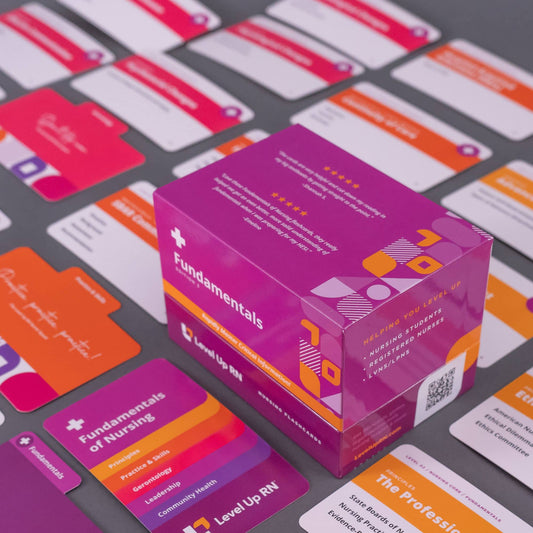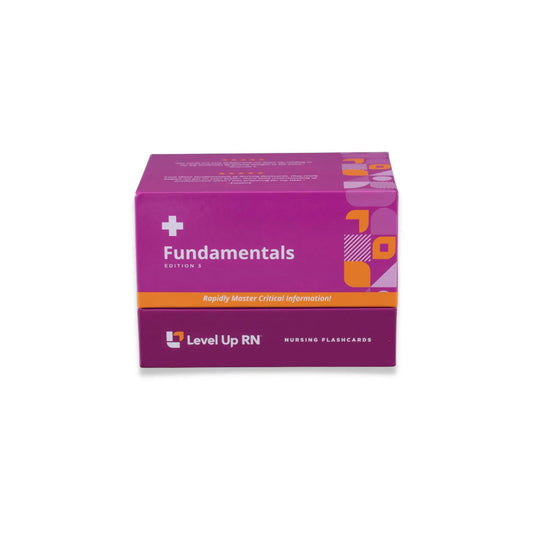Fundamentals - Community Health, part 9: Disasters and Triage
Updated: Ellis ParkerDifferent actions that should occur before, during, and after disasters. These include mitigation, preparedness, response, and recovery. the classification system used to triage during mass casualty events.
Full Transcript: Fundamentals - Community Health, part 9: Disasters and Triage
Full Transcript: Fundamentals - Community Health, part 9: Disasters and Triage
Hi, I'm Ellis with Level Up RN. In this video, we'll be chatting about management of disasters as well as how to triage during a mass casualty event. These cards can be found in the community health section of our Fundamentals of Nursing card deck. So if you have those cards, grab them and follow along with me. If you don't have that card deck, be sure to check us out at leveluprn.com. After we complete the content on these cards, I will ask you a couple of questions just to check your knowledge. Let's start with management of disasters. Disasters are, of course, by default kind of unpredictable, but there are steps that we can take before, during, and after them. These are mitigation, preparedness, response, and recovery. Mitigation relies on a good community assessment because it is the prevention and/or reduction of the causes, impacts, or consequences of a disaster. So we can do things like a risks assessment to determine what types of disasters a community is most at risk for. Inspections play a key role in this as well as education. So some of those tasks are going to be within a nurse's scope of practice and role, and some of this is just talking about how communities are going to mitigate disasters. Similarly, with preparedness, some of this is a nurse's role and some of it, I'm just talking about generally speaking within a community. But preparedness is the planning, training, and education for unavoidable disasters.
And to increase preparedness, we would want to develop things like a disaster action plan, so what to do if a disaster occurs. Identify evacuation routes, develop a communication plan, so how are we going to talk to each other or get in touch with each other if a disaster occurs, and say, cell towers are inaccessible and our cell phones aren't working? We could execute disaster drills, so practicing the actual steps of escape routes and where we would go and what we would bring. And the creation of supply kits. So bags that have water bottles or flashlights or blankets. The response to a disaster would be the actual implementation of the disaster plan that we have hopefully already prepped and educated and practiced. So this would be to actually implement those evacuations and perhaps even performing search and rescue operations. And then a key role that a nurse is going to play in the actual response to a disaster is to help triage victims. After a disaster is over, then we can begin recovery efforts, and that's going to include things like restoration. So physically rebuilding of structures, hopefully decreasing the vulnerability to future disasters, and I'd also like to point out this would include revisiting those disaster preparedness plans and action plans and making sure that if there were any issues in the response to the disaster that we have just experienced, that we can maybe tighten up some of those plans for any future disasters.
If a mass casualty event occurs, which is an event in which a lot of people are injured, then an important aspect of the nurse's role is to provide triage. Now this triage is very, very different than regular triage that a nurse would do in any given medical facility on any given day because here, we are prioritizing individuals based on their survivability with the intention to provide the greatest amount of good to the greatest amount of people. And the reason that we have to do this is because we have limited time and accessibility and resources. So again, triage for mass casualty events focuses on the greatest amount of good for the greatest amount of people. And this is a numbered and colored system, so there's class one, two, three, and four, and their corresponding colors are red, yellow, green, and black. Class one, which is red, are individuals that are experiencing a serious life-threatening injury. For example, hemorrhaging lacerations, sucking chest wounds, amputations. These are our first priority. These are patients that need to be treated first. Class two is yellow. Yellow patients have injuries that are serious, but they are not life-threatening. So an open fracture that is not hemorrhaging or a full thickness burn that is not affecting the airway. So while these patients have serious injuries, they could survive for 60 minutes without medical interventions.
Class three is green. These patients have experienced a minor injury and we sometimes refer to them as the walking wounded because while they do have an injury of some kind, they're usually up and walking around. And so these injuries include things like wrist fractures or sprains or abrasions or minor lacerations. And we're not saying these individuals don't need medical treatment, but their medical treatment could be delayed for several hours without it having a life-threatening impact. The final category is class four, which is correlated with the color black. And these individuals have suffered a mortal injury or an injury that is going to lead to death. Some examples of those are penetrating head wounds, especially if the patient has fixed and dilated pupils, or if a patient is unresponsive with agonal breathing. It sounds maybe callous, but these patients are expected and would be allowed to die in a mass casualty event. The key point here is that we do not prioritize patients who are mortally wounded even if they are still alive. And as I said, that does feel a little callous, but make sure you remember: in a mass casualty event, our focus is to provide the greatest amount of good to the greatest amount of people. So while class one or red patients have life-threatening injuries, they would be able to be stabilized in a short interim before we could provide further medical care. For example, a patient that experiences an amputation does have a life-threatening injury, but if we tourniquet that limb, then we can temporarily stabilize them and provide further medical treatment. So we do not prioritize patients that have mortal injuries even if they're still alive, and they are unfortunately expected and probably will die in a mass casualty event.
That concludes the content for this video, so let's go ahead and check your knowledge. What is one of the main roles of the nurse during a disaster or mass casualty event? One of the main roles of the nurse is to provide triage. Which triage classification would be used for a patient that is experiencing a hemorrhaging laceration? This patient would be classified as a class one or red. Describe patients who would be triaged as class three or green during a mass casualty event. These patients have minor injuries that can be left untreated for several hours and are sometimes described as the walking wounded. Thank you so much for studying with me. I really hope that you learned something new from this video. This is the last video in our community health section of our Fundamentals of Nursing flashcard deck.


